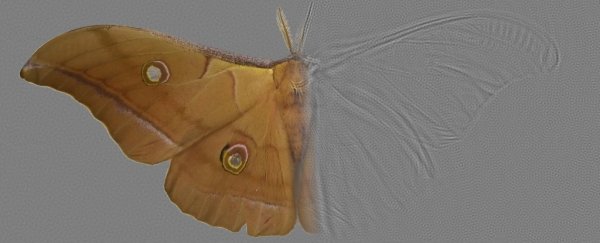Nature has a way of putting our best technology to shame. For decades now, scientists have been trying to manufacture the ultimate sound absorber - a carefully engineered material that can manage acoustic waves for stealthy movement or simple peace and quiet.
As it turns out, however, that cherished 'metastructure' may already exist in the natural world, and it's been hiding in the fluttering wings of some earless moths.
The paddle-shaped scales that pattern some moth wings are so efficient at absorbing sound, a new study claims they can be classed as a naturally occurring metamaterial. Structurally and conceptually, the authors say, they have the same core attributes.
Metamaterials typically refer to structures we engineer that can't be found in nature. Though every now and then we're surprised to discover biological structures we wished we'd thought of first, so include them as somewhat honorary metamaterials.
That's an exciting discovery given how rare these 'metameterials' are in nature. While there are a few remarkable examples identified thus far - the silk of silkworms, the iridescence of butterflies - this is the first acoustic metastructure ever discovered in the real world.
According to researchers, it's "unlike anything considered to date".
Modelling the natural structure of the wings of two species of earless moth and two species of butterfly, researchers have shown the way moth scales are uniquely spaced and sized gives them a stealthy coating a hundred times thinner than the longest wavelengths of sound it can absorb.
This allows the insects to stay both light and airborne, while also providing acoustic camouflage from echolocating bats - an achievement engineers have been aspiring to for years
"Our study demonstrates that functional implementations of this have existed in nature well before modern science," the authors conclude.
"Understanding these structures and mechanisms offers the future possibility of developing thinner and lighter noise control materials and devices."
In all likelihood, this natural metamaterial has been sculpted by millions of years of evolution, so scientists shouldn't take it too hard.
Without a means to hear the high frequency calls many bats use to locate their prey in the dark, earless species of moth that still venture out at night need ways to avoid becoming dinner
Under such unique forms of pressure, these insects have evolved a unique coating of stealthy scales, not only on their furry thorax and wing joints - as previous research has shown - but also on moth wings themselves.
The wing scales, however, are much more impressive. While the body of earless moths appears to be coated in a 1.5 millimetre shield of sound absorption, that level thickness would weigh moth wings down far too much.
Under an electron microscope, researchers have now shown the scales on moth wings create a soft coating less than 0.3 mm thick. For reference, the sound waves bats use for echolocations are approximately 17 mm.
Using ultrasound tomography, researchers tested how the wings of two earless moth species captured sound compared to the wings of two butterfly species.
Measuring the effect on wings with and without scales, the team found butterfly wings, which have not evolved under pressure from bats, showed no sound absorbing properties. On the other hand, the wings of moths have a soft carpet of scales shaped and patterned in a way that is tuned for every frequency of bat call.
These scales were able to reduce ultrasonic echoes and dampen sound even at the lowest frequencies tested.
"Such a broadband absorption is very hard to achieve in the ultrathin structures of moths' wings, which is what makes it so remarkable," explains sensory ecology expert Marc Holderied from the University of Bristol.
Other porous absorbers that achieve this level of absorption are much thicker, and they tend to only absorb sound in a narrow frequency range.
The team hopes the discovery will help us design more efficient broadband noise-cancelling devices that are also lightweight.
"The promise is one of much thinner sound absorbers for our homes and offices, we would be getting close to a much more versatile and acceptable sound absorber 'wallpaper' rather than bulky absorber panels," says Holderied.
All of that from a moth.
The study was published in PNAS.
